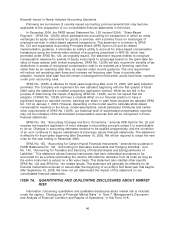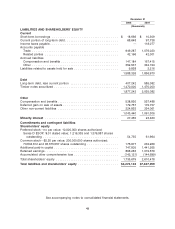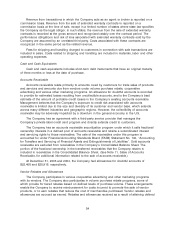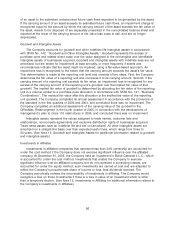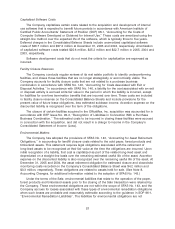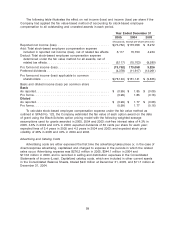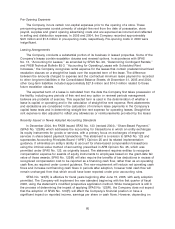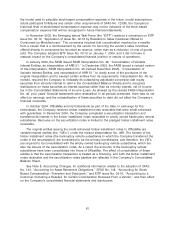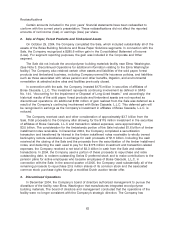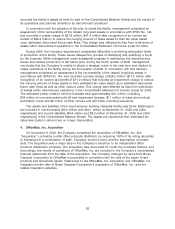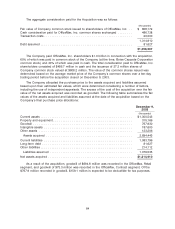OfficeMax 2005 Annual Report Download - page 60
Download and view the complete annual report
Please find page 60 of the 2005 OfficeMax annual report below. You can navigate through the pages in the report by either clicking on the pages listed below, or by using the keyword search tool below to find specific information within the annual report.of an asset to the estimated undiscounted future cash flows expected to be generated by the asset.
If the carrying amount of an asset exceeds its estimated future cash flows, an impairment charge is
recognized equal to the amount by which the carrying amount of the asset exceeds the fair value of
the asset. Assets to be disposed of are separately presented in the consolidated balance sheet and
reported at the lower of the carrying amount or fair value less costs to sell, and are no longer
depreciated.
Goodwill and Intangible Assets
The Company accounts for goodwill and other indefinite life intangible assets in accordance
with SFAS No. 142, ‘‘Goodwill and Other Intangible Assets.’’ Goodwill represents the excess of
purchase price and related direct costs over the value assigned to the net tangible and identifiable
intangible assets of businesses acquired. Goodwill and intangible assets with indefinite lives are not
amortized, but are tested for impairment at least annually, or more frequently if events and
circumstances indicate that the asset might be impaired, using a fair-value-based approach. An
impairment loss is recognized to the extent that the carrying amount exceeds the asset’s fair value.
This determination is made at the reporting unit level and consists of two steps. First, the Company
determines the fair value of a reporting unit and compares it to its carrying amount. Second, if the
carrying amount of a reporting unit exceeds its fair value, an impairment loss is recognized for any
excess of the carrying amount of the reporting unit’s goodwill over the implied fair value of that
goodwill. The implied fair value of goodwill is determined by allocating the fair value of the reporting
unit in a manner similar to a purchase price allocation in accordance with SFAS No. 141, ‘‘Business
Combinations’’. The residual fair value after this allocation is the implied fair value of the reporting
unit goodwill. The Company completed its annual assessment in accordance with the provisions of
the standard in the first quarters of 2005 and 2004, and concluded there was no impairment. The
Company completed an additional assessment of the carrying value of the goodwill in the
OfficeMax, Retail segment in the fourth quarter of 2005, in connection with the development of
management’s plan to close 110 retail stores in 2006, and concluded there was no impairment.
Intangible assets represent the values assigned to trade names, customer lists and
relationships, noncompete agreements and exclusive distribution rights of businesses acquired.
Trade name assets have an indefinite life and are not amortized. All other intangible assets are
amortized on a straight-line basis over their expected useful lives, which range from three to
20 years. (See Note 13, Goodwill and Intangible Assets for additional information related to goodwill
and intangible assets.)
Investments in Affiliates
Investments in affiliated companies that represent less than 20% ownership are accounted for
under the cost method if the Company does not exercise significant influence over the affiliated
company. At December 31, 2005, the Company held an investment in Boise Cascade L.L.C., which
is accounted for under the cost method. Investments that enable the Company to exercise
significant influence over an affiliated company, but do not represent a controlling interest, are
accounted for under the equity method; such investments are carried at cost and are adjusted to
reflect the Company’s proportionate share of income or loss, less dividends received. The
Company periodically reviews the recoverability of investments in affiliates. The Company would
recognize a loss on these investments if there is a loss in value of an investment which is other
than a temporary decline. (See Note 12, Investments in Affiliates for additional information related to
the Company’s investments in affiliates.)
56


